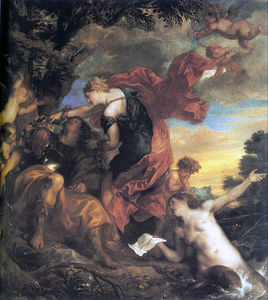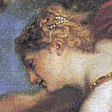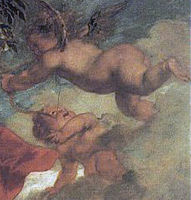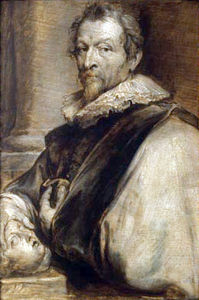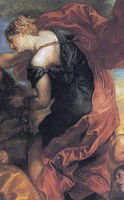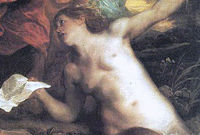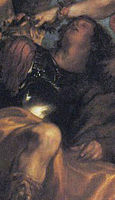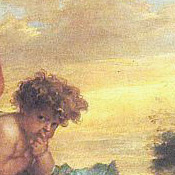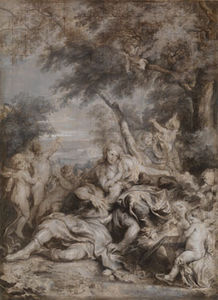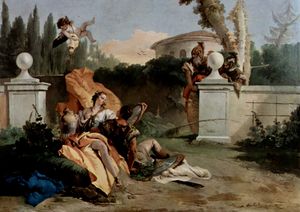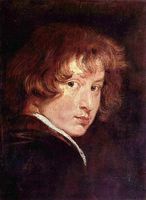Rinaldo and Armida
- Date of Creation:
- 1629
- Medium:
- Oil
- Support:
- Canvas
- Subject:
- Scenery
- Art Movement:
- Baroque
- Created by:
- Current Location:
- Baltimore, Maryland
- Displayed at:
- Baltimore Museum of Art
- Owner:
- Baltimore Museum of Art
- Rinaldo and Armida Page's Content
- Story / Theme
- Inspirations for the Work
- Analysis
- Critical Reception
- Related Paintings
- Artist
- Art Period
- Bibliography
Rinaldo and Armida Story / Theme
This work was carried out when Anthony van Dyck was in England. King Charles had a copy of the poem, Jerusalem Delivered (Gerusalemme Liberata) while he was in prison and most probably asked van Dyck to paint a scene from the book.
The story of Rinaldo and Armida derives from this poem, written by Torquato Tasso in 1582 and has interested artists, writers and composers since the 16th century.
The story is set during the First Crusade by the Romans into Jerusalem led by Goffredo, who looked to overthrow the siege by the King Argante who wanted to expand the Ottoman Empire.
This scene involving Rinaldo and Armida is about hate turned into love. The subjects here are Rinaldo, a captain of the army of Goffredo and the sorceress Armida who sides with the King. To dissuade the armies Armida woos the men with her charms and turns them against each other, thus weakening the troop. Those who followed her were all turned into animals.
On seeing Rinaldo, Armida fell in love with him and kidnapped him. In her Garden of Pleasure and secret Palace she put him under a spell and he grew idle and became infatuated with the sorceress.
Goffredo and his brother Eustazio decided to save Rinaldo and set out to find a hermit who could break the spell. The hermit gave them a diamond mirror into which the entranced Rinaldo had to look.
The two knights braved the perilous journey to the hidden palace and showed Rinaldo the mirror. With that, the spell was broken and Rinaldo left Armida who was heartbroken and wanted to die but couldn't because she was an immortal.
Many other dramatic versions of this story end with Armida converting to Christianity and ending up with Rinaldo as a mortal.
In his version, van Dyck captures the moment Armida puts Rinaldo under her spell and is about to take him to her Palace. The artist includes various other subject matter to accentuate the atmosphere. Besides two cherubs above her, there is a giggling Cupid behind her and in the water a singing Nymph who serenades the lovers.
Rinaldo and Armida Inspirations for the Work
The poem written by Torquato Tasso in 1582 has been the inspiration for many artists, particularly in 16th century Italy and France. The poem talks about heroic warriors, heroines and the dangers that existed during the first crusade. It's likely that van Dyck saw similarities between Tasso's poem and the view of the English monarchy at the time.
This theme has provided inspiration for many other artists including Giovanni Battista Tiepolo, Francois Boucher, Francesco Hayez and Nicolas Poussin, to name but a few and these work can be seen below in the Related Works section.
Hendrick van Balen:
Although the artist Hendrick van Balen did not exert a great influence on van Dyck's oeuvre, it can be seen in his traditional approach to the Flemish style of landscape painting where the subject matter contained intense detail, as seen in Rinaldo and Armida. Van Dyck fused the concepts of the realistic rendering of nature into a pastoral atmosphere that looked to elevate the focus of his work, in this case, Armida.
Rinaldo and Armida Analysis
Composition:
This painting has an S-shaped composition which allowed van Dyck to add as much detail as possible to his signature large figures. Armida is the central subject here, as van Dyck emphasizes the mystery and passion of the sorceress as she put the unsuspecting knight under her spell.
Use of space:
In Rinaldo and Armida the plane is once again on a slanted position from right to left. As the slant rises to the left, the right hand side gives the illusion of being in the distance and largely depicts the landscape. This technique helped create space and correct positioning so that the subject matter would be in exact proportion.
Color palette:
The color palette used in this work was full of very soft tones. Yellow and gold dominate the canvas and portray the idyllic, hazy atmosphere of passion and love between the sorceress and sleeping knight. The most striking feature is Armida's billowing red cape against the setting sun.
Red is also used to depict the flying cherubs above Armida, who also serve to represent passion. Red is also used for the flesh tints and to define shadow upon the skin.
Rinaldo, the sleeping knight, is painted with soft, golden hues. He is under the spell of the sorceress and therefore his state of mind is rather hazy. His trousers are evidence of van Dyck's ability to create reflective textures and this technique also shows the shadows and folds within the waning light conditions. The same technique is used for the knights' armour plate.
Van Dyck uses blue excessively for the partially clear sky and for the mountain in the background. He cleverly uses the blue so that it shows to be intensified in the sunlight as it sets to the right half of the scene.
Rinaldo and Armida Critical Reception
Rinaldo and Armida was commissioned by King Charles I of England and is generally regarded as one of Anthony van Dyck's finest paintings. His skill at bringing out the character of his subjects ensured his success and brought him many commissions throughout his career. In fact, he had so many offers of work that he couldn't keep up with them and took on many assistants in his studio to keep up with the demand.
Van Dyck's works are known for their smooth finish and bright and bold color schemes, namely his signature use of reds and browns to define depth, emotion and shape and Rinaldo and Armida is a great example of this.
In particular, van Dyck was most noted for his extensive and brilliant use of the color palette and he was able to mix the right hues and tones to create a vivid image that would render the reality of the moment and uplift the human spirit.
Although van Dyck's historical works were not as common or popular as his portraits, they successfully showed the complex psychologies of various personas engaged in a narrative. The artist did not fill the canvas with various other characters and subject matter but instead included objects and subject matter that assisted in the complex compositional aspects of the works. His focus therefore was very much on the main characters in the scene. Work such as Rinaldo and Armida contain various spatial dimensions that create astounding three-dimensional effects.
Rinaldo and Armida Related Paintings
Rinaldo and Armida Artist
From the age of just 14, Anthony van Dyck showed promising talent in the portrayal of the human face. He was already able to create the human aspect of the sitter and at the same time enlighten their deepest character traits through correct lighting and atmosphere.
Van Dyck greatly impressed King Charles I of England and was asked to create numerous works, including Rinaldo and Armida, on his behalf. An avid art fan, Charles I went on to offer van Dyck the post of England's principle court painter which saw his career go from strength to strength. The King and Queen rarely entertained other artists throughout van Dyck's time.
Van Dyck was famed for his bold color palette and signature use of reds and browns to define depth, emotion and shape and Rinaldo and Armida is a great example of such techniques.
Works such as this demonstrate the artist's competency in compositional techniques and contain various spatial dimensions that create astounding three-dimensional effects.
Unlike Rubens, van Dyck did not fill the canvas with various other characters and subject matter but instead focused on the subject by including objects and subject matter that assisted in the complex compositional aspects of the work.
Rinaldo and Armida Art Period
The Baroque style originated in Italy and its pioneers include great artists such as Michelangelo and Tintoretto. Baroque art focused on impersonal and generic works with an animated and energetic mood. The success of this art genre was promoted by the Roman Catholic Church and the aristocracy, the latter of which saw Baroque art as a means of demonstrating wealth and power.
Flemish Baroque painting developed out of the Southern Netherlands between around 1585 and 1700. There were several key artists leading this movement, including Peter Paul Rubens, Jacob Jordeans and Anthony van Dyck. Rubens trained van Dyck and many other painters and exerted greatest influence on the development of Flemish art. Van Dyck, on the other hand, played a vital role in establishing new directions in English portraiture.
Flemish Baroque painting centered on still-life, genre paintings of everyday scenes and landscape painting. Other developments in this genre were similar to those of Dutch Golden Age painting, in that artists specialized in areas such as history painting and portraiture, as was the case with Anthony van Dyck.
Rinaldo and Armida Bibliography
To read more about van Dyck and his paintings please refer to the recommended reading list below.
• Blake, Robin. Anthony Van Dyck: A Life, 1599-1641. Rowman & Littlefield Publishers, 2000
• Brown, Christopher. Anthony Van Dyck. izzoli International Publications, 1999
• Brown, Christopher. The Drawings of Anthony Van Dyck. Pierpont Morgan Library, 1991
• Cust, Lionel. Anthony Van Dyck, a Further Study. 2010
• Depauw, Carl. Anthony Van Dyck as a Printmaker. Rizzoli International Publications, 1999
• Gordenker, Emilie E. S. Anthony Van Dyck (1599-1641) : and the Representation of Dress in Seventeenth-century Portraiture (Pictura Nova 8). Brepols N. V., 2003
• Gritsai, Natalia. Great Masters: Anthony Van Dyck. Grange Books, 2004
• Marshall, Beatrice. Old Blackfriars: A Story of the Days of Anthony Van Dyck (1901). Kessinger Publishing, 2009
• Wheelock, Arthur K. Anthony Van Dyck. Harry N Abrams, 1991
• White, Christopher. Anthony Van Dyck: Thomas Howard, Earl of Arundel (Getty Museum Studies on Art). J. Paul Getty Museum, 1996

